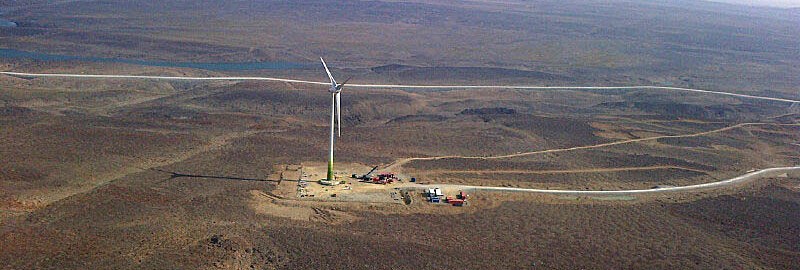Arctic renewable energy push orchestrated by six US, Canadian groups
Arctic renewable energy projects in three communities: Groups’ goal

The Canadian Arctic renewable energy groups will draw on Alaska’s experience with wind projects, hydro, solar, geothermal and biomass. AlaskaRenewableEnergy.org photo.
It ain’t New York but when it comes to renewable energy and the Canadian Arctic, if they can make it there, they’ll make it anywhere.
Six organizations have banded together to help remote Arctic communities reduce diesel power generation and expand large-scale renewable energy.
“If you can crack the nut of renewables in the Canadian Arctic, the toughest place in the world, then maybe you can export that knowledge and technology around the world,” Paul Crowley, Arctic vice-president of the World Wildlife Fund Canada, said Thursday in an interview from Iqaluit.
The groups involved include the Alaska Center for Energy and Power, Qikiqtani Inuit Association, Tugliq Energy Co., Borden Ladner Gervais LLP, the Pembina Insitute, WWF Canada and the Waterloo Institute for Sustainable Energy.
Their goal is to have a least three northern communities running large-scale, renewable energy projects within the next four years.
There are about 300 diesel-dependent communities in Canada, said Crowley and provincial and territorial leaders recently agreed at a Vancouver meeting with Prime Minister Justin Trudeau that getting remote communities off diesel generation is a priority.
A Senate report last year concluded that northern electricity systems are “aging, underperforming and at capacity.” Most of Nunavut’s 17 generators are more than three decades old, held together with “duct tape and twine,” says Crowley. Not only is the system very expensive, diesel generation produces greenhouse gases and black carbon, which absorbs the sun’s energy and speeds snow and ice melt.
The first task of the alliance of non-governmental groups is to assess 17 communities in Nunavut and the Northwest Territories for Arctic renewable energy potential, a study that’s underway now at the University of Waterloo, Ont.
Neighbouring Alaska’s recent experience suggests there are a number of options.
Gwen Holdmann, director of the Alaska Center for Energy and Power at the University of Alaska in Fairbanks, said about 70 of Alaska’s 200 or so communities are connected to grid-scale renewable energy, including almost 40 wind projects, hydro, solar, geothermal and biomass.
A number of communities are able turn off all diesel generation and run on wind power alone at times. Holdmann says her own home in Fairbanks runs entirely off solar power for much of the summer. Multi-directional solar arrays can actually generate power 24 hours a day at times in the Arctic summer.
The state of Alaska’s US$50-million a year renewable-energy fund program has spent some $271 million since 2008 while tracking the annual offsets of diesel fuel use. It reports saving about 75 million litres of diesel fuel in 2015, up from 57 million litres in 2014.

The Raglan Mine wind turbine is a rare example of Arctic renewable energy currently in use. NunatsiaqOnline.com photo.
In Nunavik, Que., a wind turbine installed at the Raglan Mine has offset 3.3. million litres of diesel fuel in its first 18 months of use.
“The challenge is really taking advantage of all these different kinds of renewable resources and integrating them effectively in a grid, where we’re maximizing the displacement of diesel fuel,” Holdmann said in an interview from Fairbanks.
“It’s really about power system integration and energy storage, flywheels and things like that.”
Holdmann notes that Alaska’s de-regulated utility structure, there are 92 different utilities in the state, and very low subsidy rates have contributed to a flexible system highly motivated to find savings.
“There’s huge drive from the communities themselves to switch over to renewable resources,” she said.
“At a macro level, we’re still using a lot of diesel fuel.”
The Liberal federal budget delivered last week committed $10.7 million over two years specifically for renewable energy projects in indigenous and northern communities that are off the grid and reliant on diesel power. That’s in addition to a $2.24-billion, five-year green infrastructure fund for First Nations communities.
The non-governmental groups will convene this fall in Iqaluit to invite local input into their assessment of the viability of renewable energy systems.
As Crowley puts it, “the stars appear to be aligning on getting renewable energy in the Canadian Arctic.”
By Bruce Cheadle of The Canadian Press.






